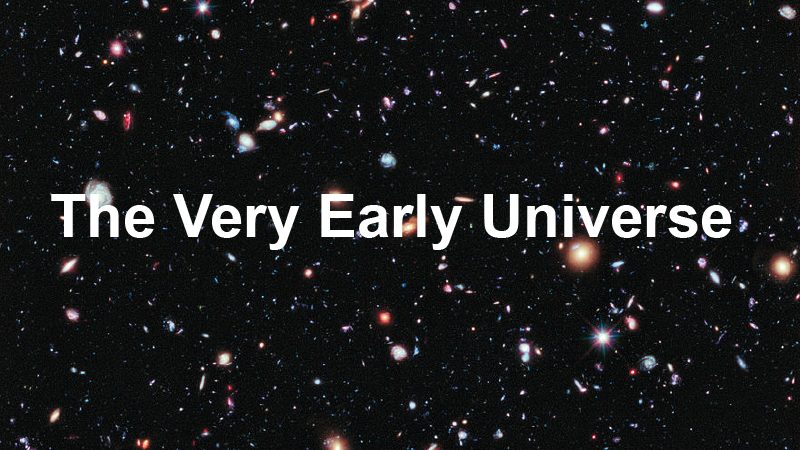The Very Early Universe
Episode #1 of the course A short history of the universe
Most people know about the Big Bang; if you extrapolate the expansion of the universe backwards, you will find that 13.8 billion years ago, all the matter and energy in our universe must have expanded from a tiny, super hot, dense point, from which it has been spreading apart and cooling ever since, forming all the galaxies and stars in our universe today.
In the very beginning, the universe was the size of a sub-atomic particle, such as a proton; we can’t say that it was ever smaller than that, because below that size, before the universe was 1/1,000,000,000,000,000,000,000,000,000,000,000,000,000,000th of a second old, it is unclear whether distance in time and space had any meaning. According to quantum physics, this is the size of the smallest units of space-time. This first 10-43rd of a second of the universe is what we call the Planck Epoch, after Max Planck, the scientist who derived these minimal “Planck units.” At this scale, the four (known) fundamental forces of nature—gravity and the strong, weak, and electromagnetic forces—all have the same strength, and in the beginning, were one force.
Where did the proton-sized universe come from? According to quantum physics, the amount of energy in a very small area of space-time is uncertain, and the smaller the area, the larger the uncertainty. Therefore, very large amounts of energy are certain to eventually appear in very small areas very briefly due to this uncertainty. Normally they disappear within this tiny period of time (keeping the amount of energy in the universe the same). But the energy of such a fluctuation could remain if it were balanced by an equal amount of negative energy. The expansion of our universe, which is basically anti-gravity, appears to carry just the right amount of negative energy to balance all the matter and positive energy in the universe! So this may be how the universe appeared out of nothing, without cause, and survived.
Scientists have little idea what the Planck Epoch was like, because even our largest particle colliders cannot reproduce the energies of that time. According to most theories, space-time and energy at this scale become a mess of complex and wildly fluctuating shapes in more dimensions than the 3+1 that we are familiar with.
The unified force of the Planck Epoch had high potential energy—like a ball on top of a hill—and as the universe expanded, the field’s unstable symmetry broke (the ball rolled downhill) and gravity separated from the other forces. This time, from 10-43 seconds until about 10-36 seconds, is known as the Grand Unified Theory (GUT) Epoch, because the three fundamental forces other than gravity–the strong, electromagnetic, and weak forces–were still unified. By the end of this time, the universe had expanded and cooled enough for the strong force, which holds nuclear particles together, to separate from the electromagnetic force and the weak force, which remained unified as the electroweak force.
At the same time, this separation of forces (“symmetry breaking”) created an “inflation field”—a field of energy which pushes things apart—and the tiny universe suddenly inflated faster than the speed of light. Inflation happened at about 10-32 seconds. The universe expanded so much that it super-cooled, relatively speaking (it was still hotter than the inside of the sun). It ended when the inflation field dumped most of its energy into radiation and the universe “reheated.” This is where the traditional Big Bang theory begins!
Recommended book
“Universe” by Robert Dinwiddie
Share with friends

